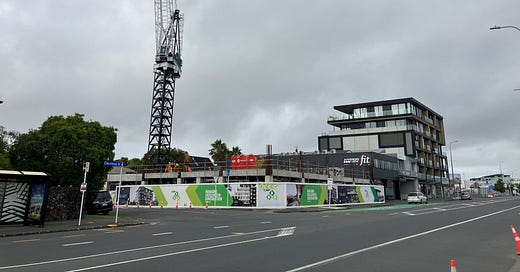The tension between housing supply and infrastructure funding
Enabling ample housing capacity is essential for housing affordability
The tension between enabling housing supply and infrastructure funding has again been highlighted, as it was revealed that Auckland Council is planning to submit against a proposed requirement in the National Planning Framework to “enable development capacity well ahead of expected demand”. They have stated that it is inefficient and doesn’t allow for effective growth and infrastructure planning.
Enabling housing capacity greater than demand is essential for allowing the market (developers) to create the supply to meet demand.
A simple way to think of this is to imagine the entire city as a street of 10 houses. 5 sites are zoned to only allow for one stand-alone house. The other 5 sites are zoned so that a 3-storey apartment block of 15 units could be built. There is demand for 30 new homes. However, the owners of those 4 of the 5 sites zoned for the apartments, don’t want to sell because they’ve lived there a long time, have just settled in with kids in the local school, or for any one of a million reasons. One owner decides to sell and gets significantly more for their because the council constrained supply and the developers are forced to bid against each other. Meanwhile only there is only a net increase of 14 homes, and supply remains below demand, despite there being zoned capacity for 75 dwellings.
Now there are a few other factors at play in real life. Some sites aren’t financially feasible even if they have zoned capacity and this can be due to a variety of factors including limitations from the zone rules or additional costs like larger earthworks on sloped sites. In New Zealand, the percentage of properties that turnover each year has typically been single digits and at most 10%. Therefore, there are limited opportunities for developers to acquire sites to redevelop. By providing ample capacity in the plan, more sites are likely to come to the market each year which are feasible for development. It also supports housing choice, in where people can live and in what kind of housing. Having a mixture of housing types in every neighbourhood supports the concept of ‘ageing in place’, where you can find a place to live that suits your needs through different life stages.
In Auckland, the Unitary Plan enables a possible 900,000 dwellings but there is projected demand for around 340,000 dwellings over the next 30 years, so we need the additional zoned capacity to ensure development can continue. It also constrains choice in typology and location, by primarily only allowing density in locations further out from the city centre.
The changes underway in responding National Policy Statement on Urban Development, which requires Tier 1 Councils to enable 6 storeys around major centres and rapid transit stations, and the Medium Density Residential Standards, which require 3 storeys to be enabled pretty much everywhere else, will provide significant additional capacity. Though the current proposed plan change continues to limit the choice element by excluding some key suburbs from upzoning through “special character protections” countering our housing affordability and climate goals by pushing development further out. This needs to be addressed but the progress Auckland has made since 2016 in providing more planned capacity has been key to more homes getting built. We should want this to continue and providing capacity well ahead of demand supports this.
Now, Auckland Council’s concerns around the ability to plan and fund infrastructure are justified and I’m sure their position is shared by most Councils around the country. Particularly those facing high growth. However, the solution is not constraining potential housing supply, it is through reforms to how we fund and manage infrastructure.




